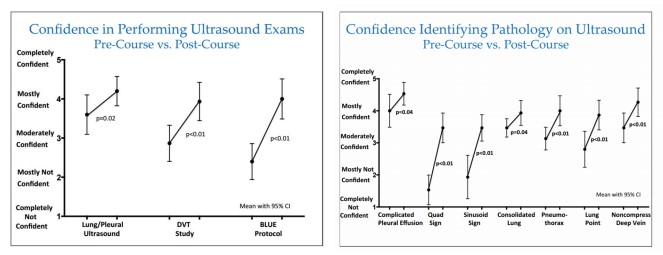New York University School of Medicine
New York, NY
Abstract Authors: Deepak Pradhan, MD, FCCP; Vikramjit Mukherjee, MD, MBBS; Bishoy Zakhary, MD; Harald Sauthoff, MD
Program Director: Doreen Addrizzo-Harris, MD, FCCP
Type of Program: Pulmonary/Critical Care Medicine Fellowship
BACKGROUND
Acute respiratory failure is a ubiquitous problem resulting in nearly 2 million yearly hospitalizations in the United States, and is associated with mortality over 20%. It requires expeditious diagnosis and treatment, and is relevant to many clinician groups including pulmonologists, intensivists, hospitalists, and emergency physicians. Point-of-care ultrasound provides rapid, bedside information on the etiology of acute respiratory failure that is non-invasive and without ionizing radiation. The Bedside Lung Ultrasound in Emergency (BLUE) protocol is a simple, reproducible algorithm utilizing ultrasound for the assessment of acute respiratory failure with an overall diagnostic accuracy of 90.5%. However, many providers are not capitalizing on this effective modality, in part due to lack of competency in performing the BLUE protocol. Effective courses designed to teach ultrasound evaluation of acute respiratory failure are lacking. We present a novel one-day course with a blended learning design to instruct learners to correctly and rapidly apply ultrasound for assessment of acute respiratory failure.
METHODS
All learners completed a pre- and post-course survey recording learner characteristics, confidence on a 5-point Likert scale for performing relevant ultrasound exams for acute respiratory failure, confidence identifying relevant pathology on ultrasound, and effectiveness of different course components. All learners also completed a pre- and post-test evaluating ultrasound knowledge and image interpretation in acute respiratory failure. Prerequisite reading materials were provided. The course was a blended learning design combining didactic and case-based lectures (Ultrasound Physics, 10 Signs of Lung Ultrasound, BLUE Protocol, Lower extremity Deep vein thrombosis study, Evidence behind BLUE protocol, and Lung/ Pleural Pathology) with hands-on small group sessions with expert faculty, and case-based simulation assessments with learner feedback after each case. Instructors used behavioral checklists during the simulation cases to objectively record learner performance of image acquisition, image interpretation, and adherence to BLUE protocol, as well as time to completion of the algorithm. Nonparametric Wilcoxon matched-pairs signed rank testing was used for statistical analyses.
RESULTS
Fifteen learners completed the course. The significant majority (79%) were current 3rd year Pulmonary/Critical Care Fellows in training. All learners had baseline ultrasound experience. Median (IQR) pre-test score was 40 (25-55)% and median (IQR) post-test score was 60 (45-80)% for the group, p<0.01. Learners felt more confident using ultrasound in performance of relevant ultrasound exams for acute respiratory failure after the course (Lung/Pleural US, Lower extremity Deep vein thrombosis study, and BLUE protocol; all p<0.02, Figure 1). Learners also felt more confident in identifying relevant pathology on ultrasound after the course (complicated pleural effusion, Quad sign, Sinusoid sign, consolidated lung, pneumothorax, lung point, and non-compressible deep vein; all
p<0.04, Figure 2). Correct learner performance via behavioral checklists of image acquisition, image interpretation, and adherence to the BLUE protocol during simulated cases on pulmonary embolism, pneumonia, pulmonary edema, pneumothorax, and asthma exacerbation for the group were median
100%, 90%, 88%, 91%, and 100% respectively, and the median times for group performance of the BLUE protocol for these simulated cases were 5:51, 3:40, 7:32, 5:32, and 6:14 minutes respectively. Learners found the didactic lectures, hands-on sessions, and simulation cases all ‘Very Useful’ (median 4 out of 5 on Likert usefulness scale), and rated the overall course as ‘Extremely Useful’ (median 5 out of 5 on Likert usefulness scale).
DISCUSSION
A 1-day blended learning design course comprised of didactic and case-based lectures, small group hands-on sessions, and simulated case assessments for learners with baseline ultrasound experience was well received and resulted in tangible improvements in knowledge, image acquisition, and image interpretation skills while increasing confidence in performing an algorithmic method to rapidly assess acute respiratory failure through bedside point-of-care ultrasound.




